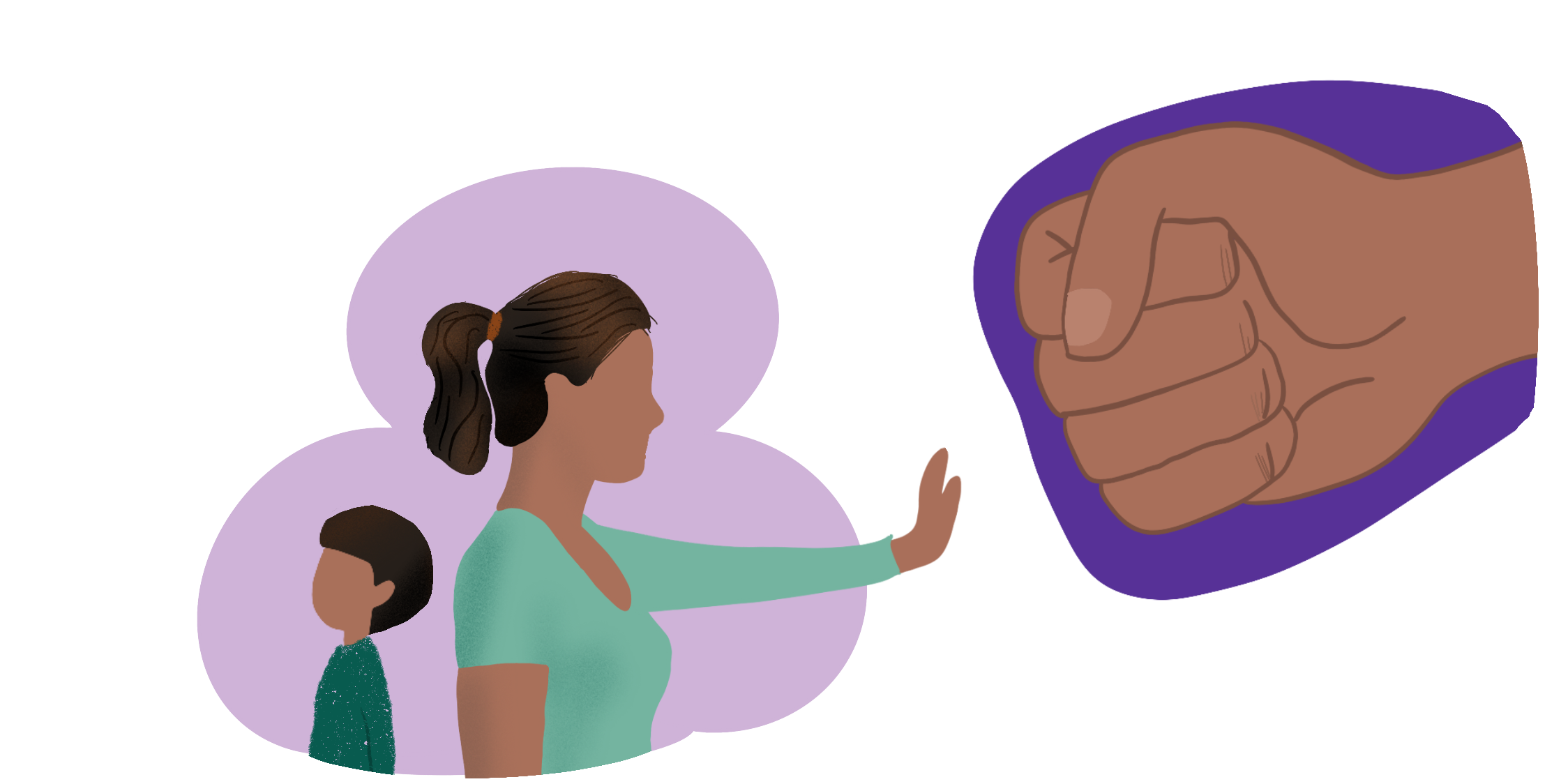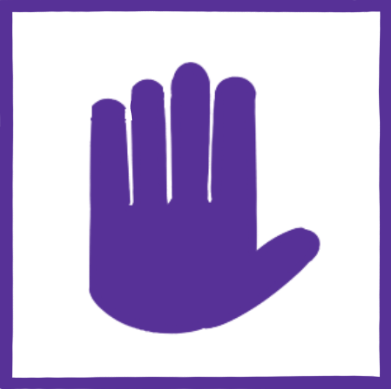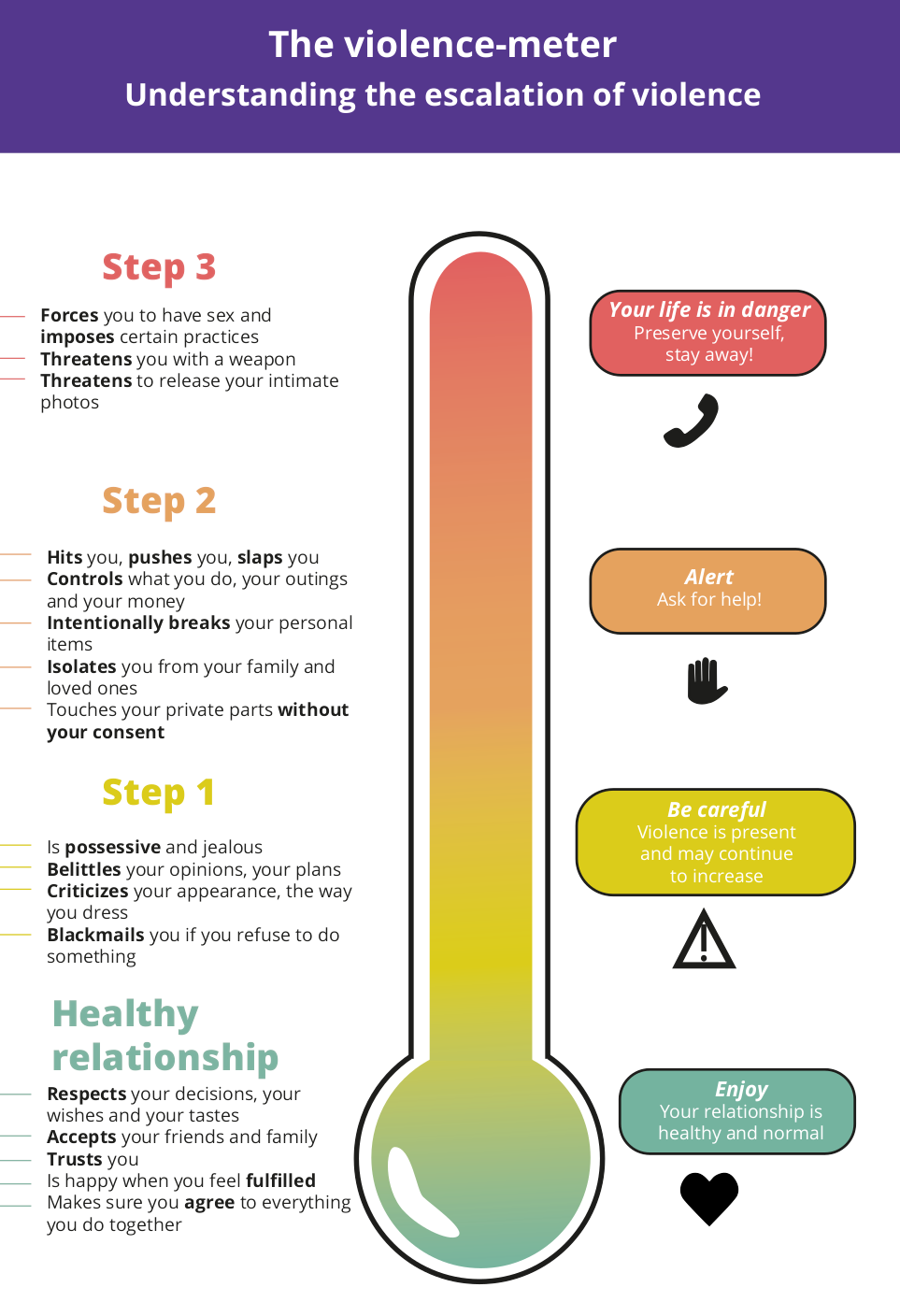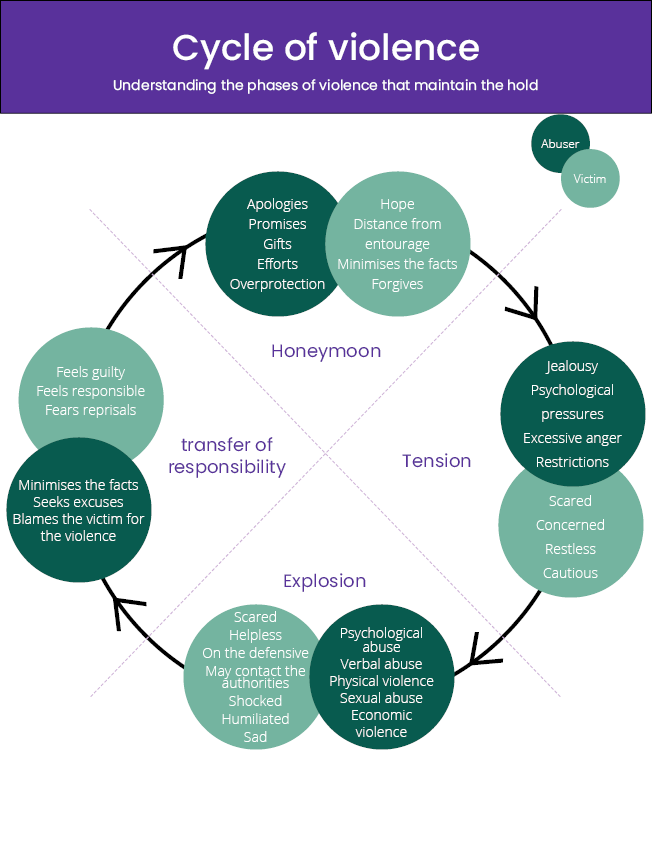
Experiencing violence or witnessing violence can lead to questions. The best way to fight domestic abuse is by understanding and recognising the different forms it can take. To better understand and fight against violence, browse through our themes:
- What is an abusive situation?
- Several forms of abuse
- Cycle and escalation of violence
- Am I a victim of abuse?
- Victims: fighting violence
- I want to help a victim
Understanding abuse

First of all, what is an abusive situation
Violence occurs when someone acts (by gestures or words) intending to harm, control or dominate. These actions, whether obvious or more subtle, have serious consequences for the person targeted: constant feelings of fear, anxiety, trauma, psychological damage, physical injury or even death.
More specifically, domestic violence is when the violence is directed at their :
- wife (or husband);
- civil union partner;
- partner;
- girlfriend or boyfriend;
- ex-wife, ex-civil union partner, ex-girlfriend or ex-boyfriend, ex-partner.
It is therefore important to understand that:
- violence has many faces;
- everyone can be confronted with it one day;
- it can happen in any social environment, at any stage of life and in any family.
Understanding the different forms of abuse
Psychological abuse
Particularities
- Used to gain or maintain control over someone;
- A subtle form of violence: difficult to detect by victims and those around them;
- Causes significant emotional damage, lowers self-esteem and can lead to depression and even suicidal behaviour;
- The victim ends up believing that they are responsible for triggering the violence.
Clues: behaviour of the perpetrator
- Constantly criticizes, belittles: “you’re not feminine enough”, “you’re good for nothing”…
- Distorts reality, accuses without proof and creates doubt: “you hear voices, I never said that!”, “I’m sure you’re cheating on me”…
- Plays with emotions and blackmails, often emotionally: “I knew you didn’t deserve my trust”, “if you leave me, I’ll kill myself”…
- Controls travels and company
- Uses silence and ignorance to create guilt
- Threat: “Think carefully before you do anything, or you won’t see your children again”.
Economic abuse
Particularities
- Widespread but not well known
- Aims to reduce the victim’s autonomy
- Occurs in both wealthy and poor environments and even with equal pay
Clues: behaviour of the perpetrator
- Impose financial control: confiscation of credit cards, demand to report expenses, etc.
- Manages the budget without consideration for the needs of the partner or family (food, care, medicine, etc.)
- Forbids their partner to work or study
- Forces their partner to pay for expenses that are not theirs
- Makes financial commitments (expenses, loans) in the name of their partner without their consent
- Imposes illegal activities (selling drugs, prostitution) on their partner and demands their earnings
Administrative abuse
Particularities
- Mainly concerns women of foreign nationality (spouses of French nationals of those benefiting from family reunification)
- Aims to block their partner’s rights claims
Clues: behaviour of the perpetrator
- Hides, keeps or destroys their partner’s identifications (passports, driver’s licence, health insurance card, etc.)
- During a stay abroad, confiscates their partner’s passport to prevent them from returning to France
- Blackmailing to obtain or renew residence permits (forced sexual intercourse)
Verbal abuse
Particularities
- Used to destabilise, humiliate and destroy
- Often trivialized
- No matter the voice or the words, the woman recognises the threatening tone: she is kept in fear and insecurity
Clues: behaviour of the perpetrator
- Seeks for frightening, make the victim feel uncomfortable: shouting, abrupt tone
- Insults: “I didn’t ask for your opinion, so shut the fuck up!”
- Makes degrading and humiliating remarks: “I thought you were smarter than that”
Physical abuse
Particularities
- Can range from shoving to homicide
- Can lead to serious consequences for the victim (concussion, serious physical and psychological injuries, etc.)
- Usually disguised: without witnesses, is covered up as an accident
Clues: behaviour of the perpetrator
- Pinching, slapping, biting, twisting arms or wrists, hitting with fists, feet, etc.;
- Chokes or attempts to choke their partner;
- Torture: inflicts burns (cigarette or other);
- Assault with a knife or firearm;
- Apply physical restraint: sequestration.
Clues: behaviour of the victim
- Wear clothes that cover the whole body even in summer;
- Claims to be clumsy to justify injuries and marks;
- Avoid certain places, even if it means taking longer detours;
- Flinches at the slightest opportunity.
Protects face or body by reflex to sudden movements
Sexual abuse
Particularities
- Difficult to admit: it remains taboo, the myth of marital duty, etc.
- The aim is to dominate their partner and destabilise them and their most intimate self
Clues: behaviour of the perpetrator
- Imposes sexual practices or intercourse on their partner;
- Humiliates partner during sex (name-calling, insults, non-consensual degrading positions);
- Forces their partner to look at or take photos or videos of a pornographic nature;
- Forces their partner into prostitution or sex with other partners;
- Is violent during sex (biting, hitting, etc.);
- Removes condom without their partner’s consent;
Understanding the cycle and escalation of violence and abuse
Understanding how abuse occurs within couples is important. Violence gradually settles in a relationship. At first, it goes unnoticed: the first manifestations are not brutal and can be mistaken for proof of love (jealousy, desire to isolate oneself with the other, etc.)
Violence often begins with psychological abuse, restrictive rules and a desire to isolate the partner. The aim is first to weaken her mentally, make her doubt herself and make her believe that she is guilty. The verbal, physical and sexual assault follows. Beware: some abusive spouses do not use physical violence, but the climate of terror they create will ultimately have the same psychological and moral consequences.
The violence is said to escalate because the frequency and severity of the assaults increase over time, sometimes leading to tragedy (homicide, suicide).
Am I a victim of domestic abuse?
Two tools can help you to assess your relationship and its dangerousness:
Why do some victims not leave?
Sometimes, understanding why some victims do not flee from abuse may be difficult. However, several factors explain why a victim of domestic violence doesn’t leave or return to their violent spouse after a break-up.
When the victim is caught in a spiral and the violence is repeated, even constant, she feels:
- great physical fatigue and possible state of depression;
- a great loss of self-esteem;
- shame;
- guilt
- anxiety at the thought of breaking up or leaving.
The abuser does a real job of undermining her mentally. Therefore, the woman victim has difficulties understanding that her situation is not normal and that she must protect herself (and her children).
The victim of domestic violence may also be afraid of:
- retaliation;
- not being able to overcome material problems;
- losing custody of their children;
- facing administrative and legal procedures;
- breaking up the family unit;
- being under pressure from the family…
For that reason, we want to enlighten women on the rights they have and can enforce. See our page:
Fighting against violence
I am a victim: I seek help
Do not hesitate to:
- contact an association or helpline such as 3919 (Violences Femmes Infos), where you will be listened to, informed and directed, or even contact the emergency numbers (15, 17, 18)
- consult a doctor, any health professional capable of taking care of you and attesting to your physical and psychological injuries, or got to the hospital to have your injuries documented.
See our page dedicated to useful contacts:
I am a victim: I plan my departure
If you have the opportunity, there are a few things you can do to make your departure easier.
- Prepare a bag and hide it in a safe and quickly accessible place (preferably in a trusted person’s home) with:
- your identifications and those of your children: ID cards, family record book, passports, immigration records, etc.
- your driver’s licence and proof of registration for your car in your name
- health insurance cards and health record and those of your children
- a picture of your partner or ex-partner to help identify them
- any evidence you may have gathered: medical certificates, written testimonies, photos, receipt of a complaint, court judgement, etc.
→ if you do not have the originals, keep photocopies of these documents.
- Important personal belongings: an outfit, valuable items
- a list of other items that you can come back for later
→ Don’t try to pack everything, go for the essentials
- Talk to your children about the situation: if they are old enough to understand, tell them what you want them to do
- write down important numbers, learn them (you and your children: they have to call themselves)
- tell people you trust about your situation: agree on a password to use via text message for them to call the police, give them things to come and collect, etc.
- ask neighbours to call the police if they hear a suspicious noise or shouting
Warning: if you are married or in a civil union, when you decide to leave, remember to fill a report or a complaint at a police station.
If you don’t, your husband or partner may divorce you for ‘abandoning the family home’ or charge you with child abduction.

How to get out of an abusive relationship?
Remember:
- Married or not, the law allows you to leave the house and go to a safe place with your children
- Being without financial resources should never be an obstacle to your departure: financial aid may be available, even for legal assistance.
- Legal procedures exist to protect you and enforce your rights (custody of children, division of property, etc)
You can start with:
- Identify the people you trust and the associations near you
- Have medical certificates drawn up that determine and attest to your physical and psychological condition, the injuries received and your possible incapacity to work (number of days of ITW) even if you are unemployed.
- File a complaint or report the incidents (always ask for a certificate of complaint)
- Put all important documents (identification, social security, proof of violence, etc) in a safe place
- Consult our “finding help” page which includes emergency numbers (17, 15, 18 and 114), association contacts, helplines (including 3919), legal information and written contacts (including the government online chat platform)
Professional or witness: I want to help a victim
I have witnessed violence or I think a woman around me is being abused.
I am a health care professional, social worker or law enforcement officer.








